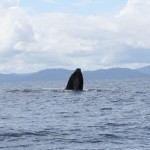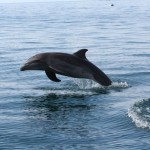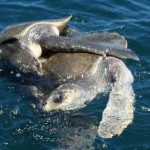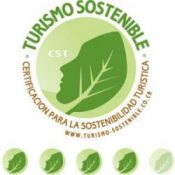Costa Rica’s marine area reaches 580,000 km2, approximately 10 times larger than its land area of only 52,100 km2. The Costa Rican ocean generates countless biological, economical and social benefits and in its resources lays the future of the country. The Marino Ballena National Park and the surrounding areas of Cano Island Biological Reserve and front bays of the entire Osa Peninsula are beautiful marine areas where locals and visitors alike can experience whales, dolphins, sea turtles, marine birds, colorful fish and amazing coral reefs.
WHALES
Whales are large, magnificent, intelligent, aquatic mammals. They breathe air through blowholes into lungs (unlike fish who breathe using gills). Whales have sleek, streamlined bodies that move easily through the water. They are the only mammals, other than manatees (seacows), that live their entire lives in the water, and the only mammals that have adapted to life in the open oceans.
Scientists believe that early whales actually walked the earth. The theory, supported by recent fossil finds in the foothills of the Himalayas, is that about 53.5 million years ago, whales were amphibious. They originated as land mammals, and gradually ventured into the water in search of food. They fed on fresh and saltwater fish. Eventually, they lost their legs and nostrils, and became the creatures we know today.
The Humpback Whale, Pilot Whale, Bryde’s, and False Orca are just some of the whales that visit the Marino Ballena National Park and the surrounding areas of Cano Island Biological Reserve and front bays of the entire Osa Peninsula.
DOLPHINS
Dolphins are marine mammals that are closely related to whales and porpoises. There are almost forty species of dolphin in seventeen genera. They vary in size from 1.2 metres (4 ft) and 40 kilograms (88 lb), up to 9.5 m (30 ft) and ten tonnes. They are found worldwide, mostly in the shallower seas of the continental shelves, and are carnivores, mostly eating fish and squid. The family Delphinidae is the largest in the Cetaceans, and relatively recent: dolphins evolved about ten million years ago, during the Miocene. Dolphins are considered to be amongst the most intelligent of animals and their often-friendly appearance and seemingly playful attitude have made them popular in human culture.
The Bottlenose Dolphin, Pan-Tropical Spotted Dolphin, Common Dolphin and Spinner Dolphin are permanent residents and can be generally observed year round breeding and feeding in the warm tropical waters of the Marino Ballena National Park, Cano Island Biological Reserve and Osa Peninsula.
SEA TURTLES
Sea turtles are large, air-breathing reptiles that inhabit tropical and subtropical seas throughout the world. Their shells consist of an upper part (carapace) and a lower section (plastron). Hard scales (or scutes) cover all but the leatherback, and the number and arrangement of these scutes can be used to determine the species. Sea turtles come in many different sizes, shapes and colors and the most common sea turtles in the South Pacific, Osa Peninsula of Costa Rica are the Green Sea turtles, Hawksbill turtles and Olive Ridley turtles.





Leave a Reply